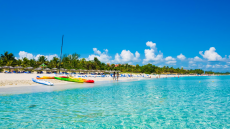
Cuba is the largest island in the Caribbean, and a popular destination for a reasonably priced beach holiday for British tourists. It has luxury hotels, golden sandy beaches, the warm Caribbean Sea and importantly a very low crime rate. This makes it safe to explore outside your hotel, which is not true of many other nearby islands. You may have heard of your friends staying entirely in their resort, but you don’t have do to that in Cuba.
However, Cuba is so much more than just a beach. It is at an exciting stage of its history. It was colonised by the Spanish, who wiped out or forcibly assimilated the indigenous native population by 1550. They learned how to cultivate tobacco and make cigars, which even today are an important part of the Cuban economy. So was the sugar cane, but it’s no longer an important part of the economy, except for the crop which gets turned into the famous Rum. The Spanish built many beautiful buildings and attractive towns which give Cuba its vibrant history. But they also imported slaves as labour for the tobacco fields, and today the DNA of the Cuban people is a unique mix of the three peoples. The Cubans are themselves one of the best things about visiting Cuba. They are almost universally friendly, kind, and hospitable, but they’re also musical and keen dancers.
By the 1950s the ruling regime was corrupt. Many Cubans were very poor and had no access to education. Fidel Castro, a young lawyer, after losing a legal battle to oust Batista (the President), raised a small army in Mexico with the help of Ernesto Che Guevara, the famous Argentinian revolutionary. They landed in Cuba with as few as 12 fighters, planning to be joined by others once in Cuba. After a guerrilla war with great bloodshed, Castro took power and Batista and many other wealthy Cubans fled to the USA. They often went to Miami, which still has a district called “little Havana” due to the number of Cubans living there.
Relations with the United States quickly became very difficult. Castro’s group were communists, and the “Cold War” you’ve probably learned about in history lessons was at its height. The US government stopped trade with Cuba, making the Cuban economy weaker. Then in 1991, the Soviet Union collapsed, and they were Cuba’s main trading partner. In 1996, the US also prevented companies outside the USA to trade with Cuba – or if they did, they would lose the right to trade in the USA. The economy in Cuba was brought to its knees and Fidel termed it the “special period”.
In 2015 Barack Obama announced softening of the embargo, an American embassy was re-established in Havana (the capital) and it seems as if there will be much more interaction between Cuba and the USA. This might lead to improved prosperity for Cuba’s people.
Currently, the main income from overseas is tourism. There is a beach area at Varadero about 3 hours from Havana, the capital. There are other beach areas in the south of the island, near Santiago. They are all very beautiful, and just as good as those on Barbados.
The crown jewel is the aforementioned capital, Havana. It has amazing buildings, music, nightlife and people. Best of all, due to the trade embargo (which stopped the importation of new cars) there are hundreds of 1950s old American cars. These have been lovingly kept on the road, and you can go for a ride in. Go and see for yourself what a unique place this island is, before the Americans start flooding in.
Image from: http://www.topflight.ie/worldwide/cuba

0 Comment:
Be the first one to comment on this article.